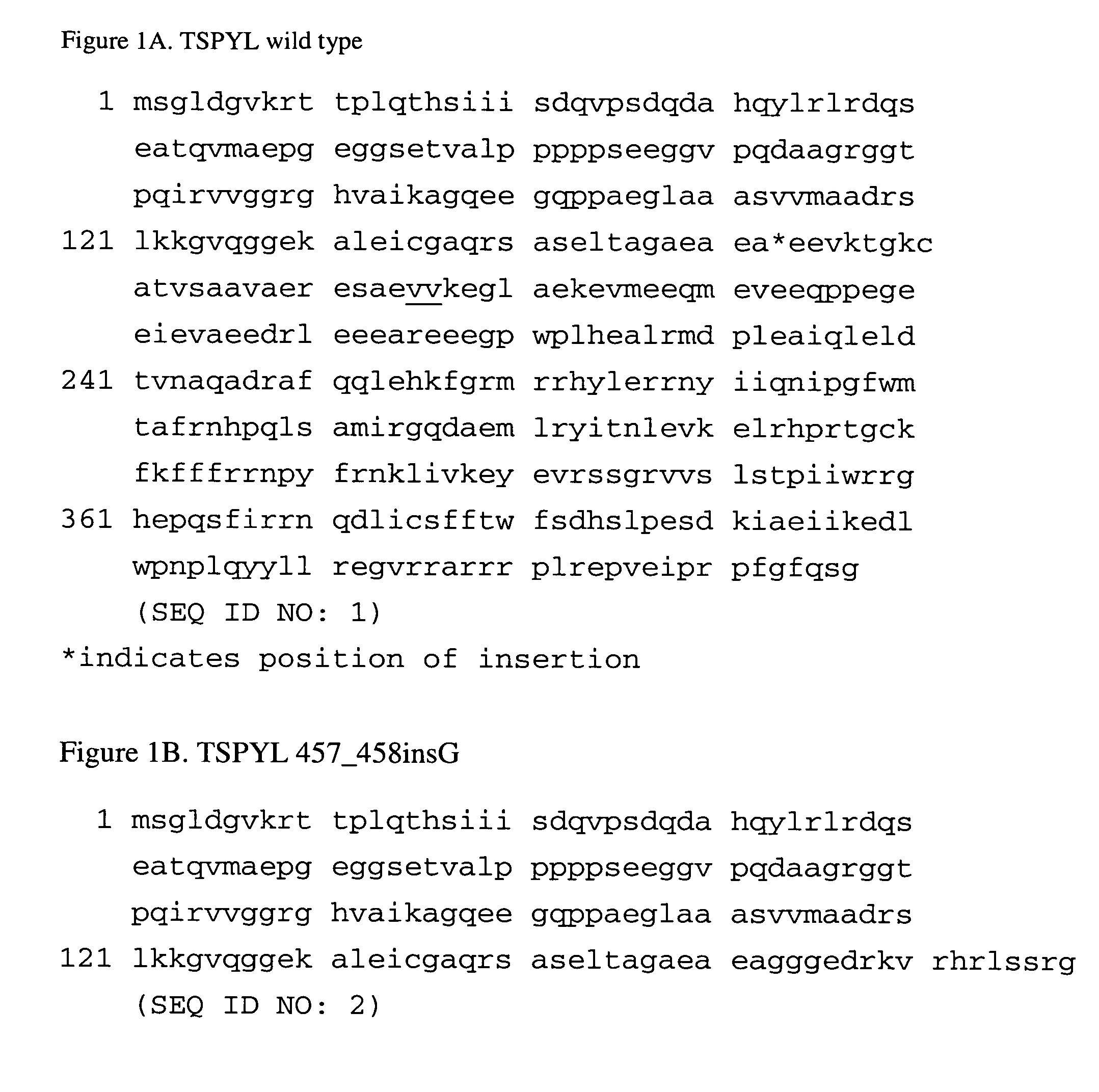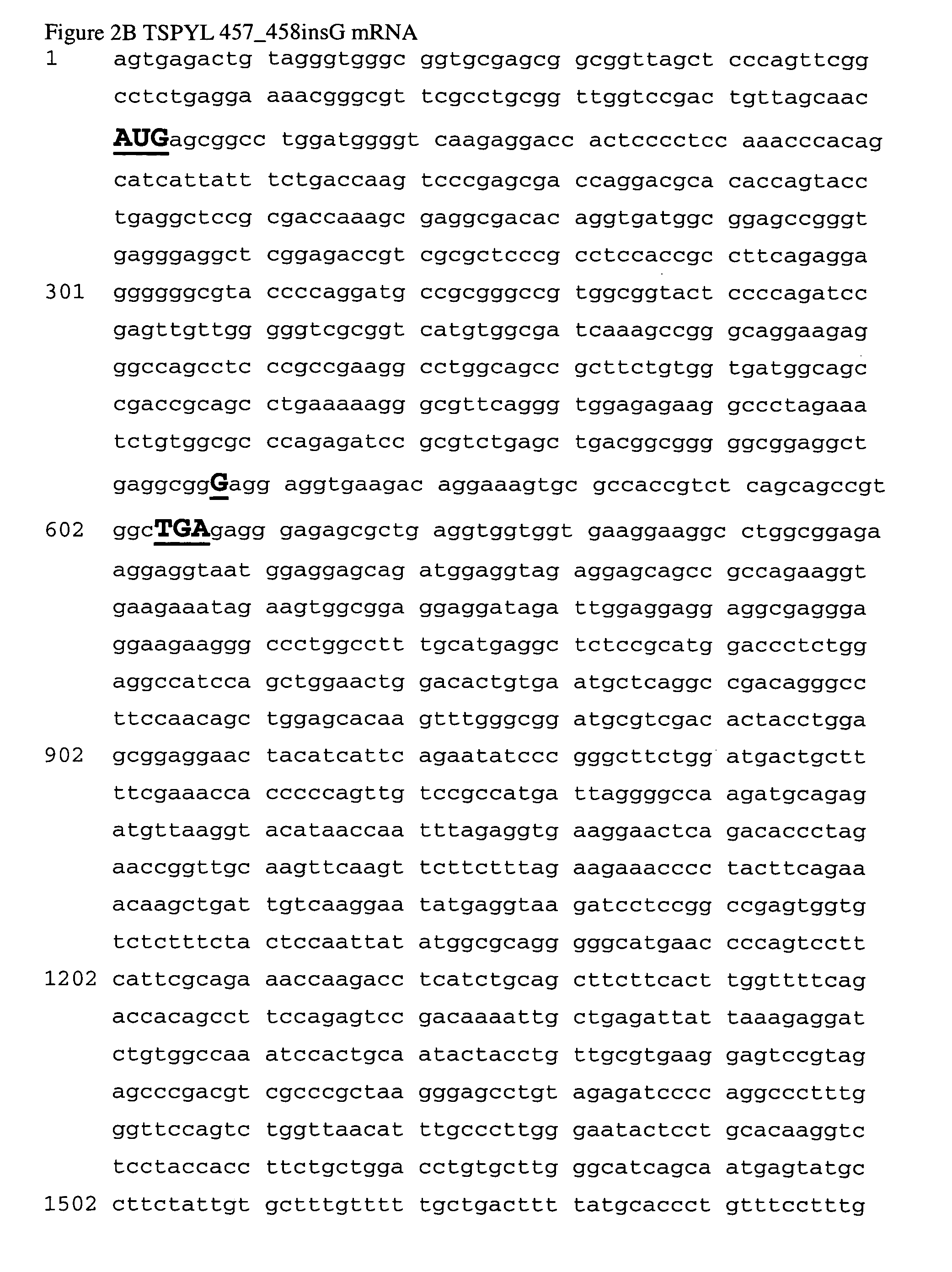Association of TSPYL polymorphisms with SIDDT syndrome
a technology of tspyl polymorphisms and siddt syndrome, which is applied in the field of association of tspyl polymorphisms with siddt syndrome, can solve the problems of difficult clinical recognition in the neona
- Summary
- Abstract
- Description
- Claims
- Application Information
AI Technical Summary
Benefits of technology
Problems solved by technology
Method used
Image
Examples
example 1
Mapping SIDDT
[0087] All DNA samples used in mapping and sequencing studies of SIDDT syndrome were acquired from patients and their families at the Clinic for Special Children, Strasburg, Pa. Over the past two generations, nine families from the Old Order Amish community of Mifflin and Juniata counties have lost twenty-one infants to a disorder locally known as Swarey syndrome. Samples were collected from affected individuals, their parents, and siblings. In addition, samples from other sibships were collected based on medical records and family interviews which indicated that affected children had been born into these families.
[0088] Comprehensive genealogies for all affected individuals were prepared from private and published family records.
[0089] SNP Genotyping was done using the GeneChip® Mapping 10K Mapping Array and Assay Kit (Affymetrix, Inc., Santa Clara, Calif.). This protocol is slightly modified from Kennedy et al.Nat. Biotechnol. 21:1233-1237 (2003). DNA from whole bl...
example 2
Sequencing Candidate Genes
[0092] Mutation analysis was performed for two candidate genes in the linked region on chromosome 6q22.1c-q22.2d: TSPYL and TSPYL4 (Genbank #AL050331 contains both genes). The exon of each target gene was amplified using specific oligonucleotide primers and 30-50 ng of genomic DNA from affected and unaffected family members. The TSPYL gene lacks introns and contains a coding region of 1,314 bases (GenBank accession no. AL050331). The mRNA is about 3200 bases in length (GenBank XM—371844) and the mature TSPYL protein is 437 amino acids. Primer sequences for TSPYL PCR amplification were
(forward)5′-AGATCTCCAGTCCTGACGACAC-3′(SEQ ID NO: 6)and(reverse)5′-AGGAAACAGGGTGCAGAAAAGT-3′.(SEQ ID NO: 7)
[0093] Primer sequences for PCR amplification of TSPYL4 were
AAAACTCCCCTTCCAGACTGAC(SEQ ID NO: 8)andCACAATGCAGAAAAGCATGAAG.(SEQ ID NO: 9)
[0094] PCR products were purified using QiaQuick columns (Qiagen) as per manufacturer's instructions, and then sequenced using the Bi...
example 3
Subcellular Localization of Mutant and Wild Type TSPYL Protein
[0097] Full-length and truncated TSPYL cDNAs were amplified using gene-specific primers for the full-length: forward, CACCATGAGCGGCCTGGATGGGGTCAAGAGG (SEQ ID NO: 17); reverse, TAGCTCGAGACCAGACTGGAACCCAAAGGGCCTGGGGATC (SEQ ID NO: 18); and the truncated: forward, CACCATGAGCGGCCTGGATGGGGTCAAGAGG (SEQ ID NO: 19); reverse, TAGCTC GAGTGGCGGCTGCTCCTCTACCTCC (SEQ ID NO: 20) versions from genomic DNA using AmpliTaq Gold® (Applied Biosystems) or the Expand High Fidelity PCR System (Roche, Indianapolis). Cycling conditions were an initial denaturation step of 94° C. for 2 min followed by 30 cycles of 94° C. for 15 sec, 68° C. for 1 min, and 72° C. final extension step at 72° C. for 10 min with AmpliTaq or 94° C. for 2 min followed by 9 cycles of (94° C. for 15 sec, 68° C. for 1 min, and 68° C. for 105 sec) followed by 94° C. for 25 sec and then 24 cycles of (68° C. for 1 min, 72° C. for 3 min), with a final extension step at 72° C....
PUM
| Property | Measurement | Unit |
|---|---|---|
| Nucleic acid sequence | aaaaa | aaaaa |
| Stability | aaaaa | aaaaa |
| Electrophoretic mobility | aaaaa | aaaaa |
Abstract
Description
Claims
Application Information
 Login to View More
Login to View More - R&D
- Intellectual Property
- Life Sciences
- Materials
- Tech Scout
- Unparalleled Data Quality
- Higher Quality Content
- 60% Fewer Hallucinations
Browse by: Latest US Patents, China's latest patents, Technical Efficacy Thesaurus, Application Domain, Technology Topic, Popular Technical Reports.
© 2025 PatSnap. All rights reserved.Legal|Privacy policy|Modern Slavery Act Transparency Statement|Sitemap|About US| Contact US: help@patsnap.com



